
Orange County is a county located in the Piedmont region of the U.S. state of North Carolina. As of the 2020 census, the population was 148,696. Its county seat is Hillsborough.

Guilford County is a county located in the U.S. state of North Carolina. At the 2020 census, the population was 541,299. In 2022, the population was estimated to be 546,101, making it the third-most populous county in North Carolina. The county seat, and largest community, is Greensboro. Since 1938, an additional county court has been located in High Point. The county was formed in 1771. Guilford County is included in the Greensboro-High Point, NC Metropolitan Statistical Area, which is also included in the Greensboro–Winston-Salem–High Point, NC Combined Statistical Area.
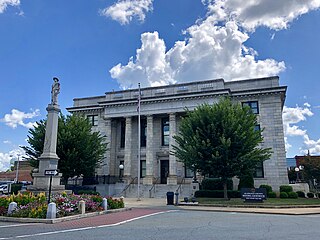
Alamance County is a county in North Carolina. As of the 2020 census, the population was 171,415. Its county seat is Graham. Formed in 1849 from Orange County to the east, Alamance County has been the site of significant historical events, textile manufacturing, and agriculture.
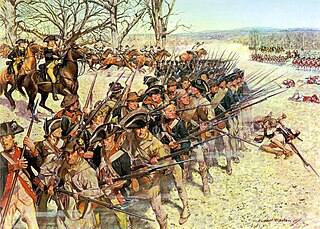
The Battle of Guilford Court House was on March 15, 1781, during the American Revolutionary War, at a site that is now in Greensboro, the seat of Guilford County, North Carolina. A 2,100-man British force under the command of Lieutenant General Charles Cornwallis defeated Major General Nathanael Greene's 4,500 Americans. The British Army, however, suffered considerable casualties.
Snow Camp is an unincorporated community in Alamance County, North Carolina, United States.
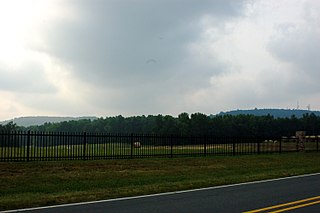
Cane Creek Mountains is a small mountain range that lies south of Burlington, North Carolina. The range covers an area including Alamance County, Guilford County, Randolph County, and Chatham County in North Carolina.

Great Alamance Creek, also called Big Alamance Creek, is a 37-mile long creek that is a tributary of the Haw River. The creek's headwaters are in Guilford County, but it flows primarily through Alamance County, North Carolina. It is a major source of water for the cities of Burlington and Greensboro through the Lake Mackintosh Reservoir. It was called "Alamance" after an old local Native American word used to describe the blue-colored mud in the bottom of the creek.

David Fanning was a Loyalist leader in the American Revolutionary War in North and South Carolina. Fanning participated in approximately 36 minor engagements and skirmishes, and in 1781, captured the Governor of North Carolina, Thomas Burke, from the temporary capital at Hillsborough. Additionally, Fanning was captured by Patriot forces 14 times throughout the war, each time escaping or receiving a pardon. After the British defeat in the war, Fanning fled to Canada, where he was elected to the Legislative Assembly of New Brunswick from 1791 to 1801 representing Kings County. After being convicted of rape in 1801, Fanning was expelled from New Brunswick, and settled in Nova Scotia, where he lived the remainder of his life.
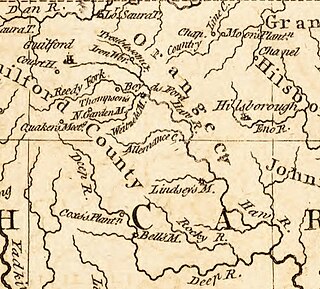
The Battle of Lindley's Mill took place in Orange County, North Carolina, on September 13, 1781, during the American Revolutionary War. The battle took its name from a mill that sat at the site of the battle on Cane Creek, which sat along a road connecting what was then the temporary state capital, Hillsborough, with Wilmington, North Carolina.
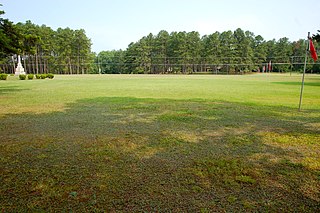
Alamance Battleground is a North Carolina State Historic Site commemorating the Battle of Alamance. The historic site is located south of Burlington, Alamance County, North Carolina in the United States.
The Snow Camp Theatre is semi-professional theatre company in Snow Camp, an unincorporated community in southern Alamance County, North Carolina that brings the voices of the past into the hearts and minds of a modern audience from around the world by producing engaging historical dramas that inspire and entertain.
John Cooper was a political leader of the American Revolution in New Jersey. He was likely the main author of the New Jersey Constitution of 1776, and served as one of the first judges of Gloucester County. An outspoken abolitionist, Cooper called for New Jersey to end slavery immediately, and argued against a more gradual approach to emancipation. A Quaker who was disowned by the Society of Friends for his political actions during the revolution, he was likely buried in the Quaker cemetery in Woodbury, New Jersey, in an unmarked grave. He was the estranged younger brother of Quaker abolitionist David Cooper.
Spring Friends Meeting House is a historic Quaker meeting house located at Snow Camp, Alamance County, North Carolina. The fourth and current meeting house was built in 1907, and is a small rectangular frame one-story gable-front building. It features Gothic Revival style lancet windows and a short, plain rectangular cupola with pyramidal roof. Spring Friends Meeting is an active congregation of Quakers from the Alamance, Chatham, Orange, Guilford and Randolph County area of North Carolina. Members of the Religious Society of Friends first started "meeting at the spring" around 1761, with the congregation formally recognized by North Carolina Yearly Meeting in 1773. The adjacent contributing cemetery dates from the founding of the meeting, about 1761. It contains the graves of some of the earliest Quaker settlers in Alamance County, as well as the unmarked graves of approximately 25 American Revolutionary War soldiers killed in the 1781 Battle of Lindley's Mill. The battle itself was waged around the meeting house, with governor Thomas Burke and other officials held prisoner in the original meeting house during the battle.
Simon A. Dixon was the founder and prominent member of the community of Snow Camp, North Carolina. He was also one of the founding members of the Cane Creek Friends Meeting, the first Quaker community in the Piedmont region of North Carolina.

The Battle of Alamance, which took place on May 16, 1771, was the final battle of the Regulator Movement, a rebellion in colonial North Carolina over issues of taxation and local control. Named for nearby Great Alamance Creek, the battle took place in what was then Orange County and has since become Alamance County in the central Piedmont area, about 6 miles (9.7 km) south of present-day Burlington, North Carolina.
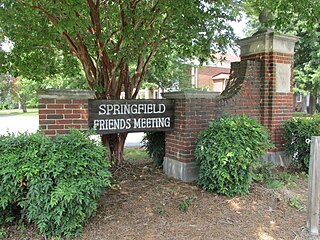
Springfield Friends Meeting is an historic Quaker meeting located in High Point, North Carolina.
Charity Wright Cook was an American Quaker minister.
Cane Creek is a 24.21 mi (38.96 km) long 4th order tributary to the Haw River, in Alamance County, North Carolina. This Cane Creek is located on the right bank of the Haw River.
Thomas Jefferson Hadley was an American politician, settler and soldier in the American Revolutionary War. He played a prominent role in the signing of North Carolina's constitution in 1776.













